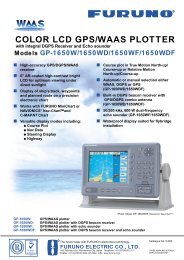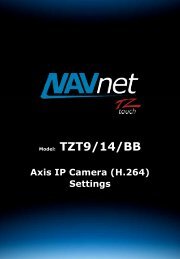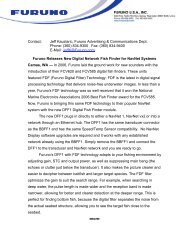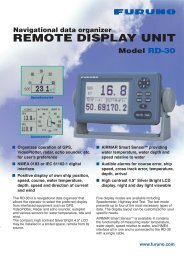Connecting FLIR to TZtouch - Furuno USA
Connecting FLIR to TZtouch - Furuno USA
Connecting FLIR to TZtouch - Furuno USA
Create successful ePaper yourself
Turn your PDF publications into a flip-book with our unique Google optimized e-Paper software.
<strong>FLIR</strong> M-Series and NavNet TZ<strong>to</strong>uch<br />
Overview<br />
The following example illustrates the integration of the <strong>FLIR</strong> M-Series in<strong>to</strong> a NavNet network. The M-<br />
Series and the JCU controller are set with a fix IP address compatible with NavNet TZ<strong>to</strong>uch. When you<br />
purchase a <strong>FLIR</strong> (with JCU), it will have a different IP address and will require changes before it is<br />
used with the TZ<strong>to</strong>uch system.<br />
Installation<br />
<strong>FLIR</strong> Configuration<br />
You have <strong>to</strong> assign the M-Series and the Controller (JCU), a fixed IP address. We recommend you use<br />
192.168.252.200 / 255.255.255.0 for the M-Series Camera, and 192.168.252.201 / 255.255.255.0<br />
for the JCU (although any IP beginning with 192.168.252.x would work as long as they don’t collide<br />
with any existing IP).<br />
The <strong>FLIR</strong> M-Series and the JCU controller are UPnP-enabled devices. You can easily see the list of<br />
UPnP-enabled devices from your computer by opening “My Network Places” if using a Microsoft XP<br />
computer or “Network” if using a Vista, Windows 7 or Windows 8 computer. Note that the M-Series<br />
and JCU will only appear on your PC, if they are all on the same network domain.<br />
Normally, the JCU gets its power from the camera when directly connected <strong>to</strong> the M-Series. When<br />
connecting the JCU <strong>to</strong> a HUB or Switch, you must use a power injec<strong>to</strong>r (48V) <strong>to</strong> power the unit (see<br />
diagram above).<br />
When the computer is connected <strong>to</strong> the M-Series Camera and JCU via an Ethernet cable or via a<br />
Hub/Switch (without router or DHCP server on the network), the M-Series and JCU au<strong>to</strong>matically<br />
assign themselves an IP address of 169.254.x.x / 255.255.0.0. In order <strong>to</strong> access the configuration
page of the M-Series and JCU, you need <strong>to</strong> setup your PC on that network (ex: 169.254.1.2 /<br />
255.255.0.0)<br />
Note: If your computer is set <strong>to</strong> “obtain an IP address au<strong>to</strong>matically,” it should au<strong>to</strong>matically set an IP<br />
address of 169.254.x.x from the <strong>FLIR</strong> after two minutes. However, it is easier <strong>to</strong> directly fix the PC IP<br />
address at 169.254.1.2 / 255.255.0.0.<br />
Note: If the JCU and the M-Series were previously assigned another IP address, you can display the<br />
JCU IP address by pressing the COLOR but<strong>to</strong>n while pushing the puck. You can then assign an IP<br />
address <strong>to</strong> your PC accordingly, and thus be able <strong>to</strong> access the M-Series and JCU configuration page.<br />
Once the computer is on the same domain as the M-Series and JCU, and UPnP is enabled, you should<br />
see the M-Series and JCU icon under “My Network Places” (XP) or “Network” (Vista/Windows 7/<br />
Windows 8):<br />
Note: If the devices do not appear, try <strong>to</strong> restart the M-Series and JCU, then check if your computer is<br />
setup <strong>to</strong> display UPnP notifications:<br />
Using Windows XP:<br />
‐ Start the Control Panel and go <strong>to</strong> Add/Remove programs<br />
‐ On the left-hand side, select the Add/Remove Windows components<br />
‐ From the Windows Component Wizard, scroll down <strong>to</strong> Networking Services, then highlight<br />
and select the “Details” but<strong>to</strong>n<br />
‐ Check the box <strong>to</strong> enable the UPnP User Interface and select Ok<br />
‐ Select Next when returning <strong>to</strong> the Windows Component Wizard<br />
‐ Select Finish<br />
Using Windows Vista and Windows 7<br />
‐ Turn on “Network Discovery” on the “Network” page as highlighted below:
CAMERA SETUP:<br />
Double click on the M-SERIES icon <strong>to</strong> open its configuration webpage. To configure a fixed IP address,<br />
click on “Network Setup”:<br />
Select the Static (fixed) option rather than Dynamic:<br />
The screen will refresh, and the IP, Mask, and Gateway fields will change from grey <strong>to</strong> white,<br />
indicating they can accept user entries. Once you have entered the appropriate IP address and subnet<br />
mask (192.168.252.200 / 255.255.255.0 in this example), click on the “Save” link and wait 1 minute.<br />
Note: You will not be able <strong>to</strong> access anymore the M-Series configuration page after changing its IP<br />
address (until you change the IP address of your computer later in this process).
JCU SETUP<br />
Go back <strong>to</strong> “My Network Places” or “Network” and double click on the JCU icon <strong>to</strong> open its<br />
configuration page.<br />
Set the Network Addressing <strong>to</strong> “Static”:<br />
Enter the appropriate IP address and subnet mask (192.168.252.201 / 255.255.255.0) and click on<br />
the “Save”.<br />
FINAL SETUP<br />
After changing the IP address of the M-Series Camera and JCU, change the IP address of the PC<br />
(192.168.252.10 / 255.255.255.0) <strong>to</strong> confirm that you see the <strong>FLIR</strong> and JCU icon again in “My<br />
Network Place” (XP) or “Network” (Vista/Windows 7,8).<br />
Note: You may need <strong>to</strong> restart the Camera and JCU for the Icon <strong>to</strong> appear in “My Network Place”.<br />
TZ<strong>to</strong>uch Configuration<br />
Press the [HOME] key, the [MENU] but<strong>to</strong>n and select [Camera]. Press [Scan] under “<strong>FLIR</strong><br />
Installation”:
This should au<strong>to</strong>matically enter the IP address of the M-Series. If the M-Series is correctly detected,<br />
you should see a green light:<br />
IMPORTANT: If the M-Series is not discovered au<strong>to</strong>matically, refer <strong>to</strong> the appendix (at the end of this<br />
document) <strong>to</strong> configure the internal M-Series NEXUS server.<br />
Once the <strong>FLIR</strong> has been detected, select the video input where the analog video output of the <strong>FLIR</strong> is<br />
connected:<br />
Note: You could connect the analog video output of the M-Series <strong>to</strong> an AXIS IP video converter. In<br />
that case, you would select the corresponding IP Camera feed in the menu above.<br />
Using an AXIS converter allows the video <strong>to</strong> be distributed on the network and available on every<br />
TZ<strong>to</strong>uch MFD.
APPENDIX<br />
How <strong>to</strong> enable the discovery and control of the M-Series from the PC<br />
In some instances, the internal server of the M-Series (“NEXUS” server) is configured in a way that<br />
prevents the PC from discovering it and controlling it. If you are unable <strong>to</strong> discover the M-Series from<br />
your TZ<strong>to</strong>uch display but are able <strong>to</strong> use the Web Control of the M-Series <strong>to</strong> control it via a web<br />
browser on your PC, follow the guide below.<br />
Note: If you are not able <strong>to</strong> control the M-Series from a Web Browser on your PC, make sure that the<br />
Ethernet connection and IP addresses are correctly setup.<br />
Open a Web Browser and type the IP address of the M-Series: http://.<br />
Example: http://192.168.252.200<br />
Note: To access the Web Server configuration, just type the IP address (do not add any port number)<br />
The Nexus configuration page should appear. Log in as an admin (default password is “indigo”)<br />
Click on “Configuration File”:
Scroll at the very bot<strong>to</strong>m of the page and click on “Download Configuration File”<br />
Save the file somewhere on your computer (on the desk<strong>to</strong>p for example).<br />
Open the configuration file (“server.ini”) with NotePad and look for the section “[Networking<br />
Configuration]”<br />
Set “Enable Network Discovery”, “Enabled” and “Allow Anonymous Clients” <strong>to</strong> “yes”:<br />
Note: You can search the text file for “Anonymous”, “Discovery” and “Enabled” <strong>to</strong> find the line you<br />
need <strong>to</strong> check.<br />
Save the file.
Note: Make sure that you don’t modify anything else.<br />
Go back <strong>to</strong> the Nexus Configuration page (you might have <strong>to</strong> log in again), select “Configuration File”<br />
and scroll down <strong>to</strong> the bot<strong>to</strong>m of the page. Click on “Choose file” and select the “server.ini” file you<br />
just modified. Click on “Upload”.<br />
The <strong>FLIR</strong> M-Series Nexus server needs <strong>to</strong> be restarted <strong>to</strong> take the changes in<strong>to</strong> account.<br />
Go <strong>to</strong> the very <strong>to</strong>p of the page (header) and click on “S<strong>to</strong>p”<br />
Wait until the Start but<strong>to</strong>n appears, and then click on it.<br />
Your TZ<strong>to</strong>uch display should now be able <strong>to</strong> detect and control the Camera.

















